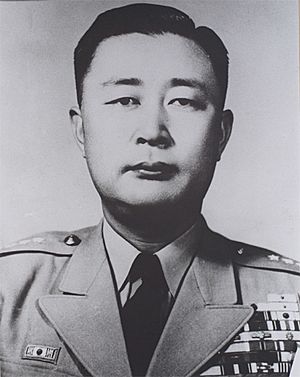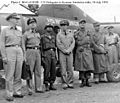Paik Sun-yup facts for kids
Quick facts for kids
Paik Sun-yup
백선엽 白善燁 |
|
|---|---|

1951 Military portrait of General Baik Seon-yup
|
|
| Born | 23 November 1920 Chinnanpo-gun, Heian'nan-dō, Korea (now Nampho, South Pyongan Province, North Korea) |
| Died | 10 July 2020 (aged 99) Seoul National University Hospital, Seoul, South Korea |
| Allegiance | |
| Service/ |
|
| Years of service | |
| Rank | |
| Commands held | 5th Infantry Regiment 5th Infantry Division 1st Infantry Division I Corps II Corps Republic of Korea Army Republic of Korea Armed Forces |
| Battles/wars | World War II Korean War
|
| Awards |
|
| Paik Sun-yup | |
| Hangul | |
|---|---|
| Hanja | |
| Revised Romanization | Baek Seon-yeop |
| McCune–Reischauer | Paek Sŏnyŏp |
Paik Sun-yup (Korean: 백선엽; Hanja: 白善燁; RR: Baek Seon-yeop; November 23, 1920 – July 10, 2020) was a very important South Korean military officer. He is famous for being the first four-star general in South Korea's history. Paik Sun-yup played a key role during the Korean War. After his military career, he also served as a diplomat and government official for the Republic of Korea.
Contents
Early Life and Education
Paik Sun-yup was born on November 23, 1920, in Tokhung, Korea. He grew up with an older sister and a younger brother. Their mother raised them after their father passed away.
In 1925, Paik's family moved to Pyongyang. They lived in a small, rented room. His mother and sister worked at a rubber factory to help the family. This allowed Paik to attend Mansu Primary School. He later transferred to Yaksong Primary School. After that, he spent five years studying to become a teacher at Pyongyang Normal School. However, in 1939, he chose a different path. He decided to join the Mukden Military Academy in Manchukuo.
Paik's Military Career
Starting His Military Journey
After graduating from the Mukden Military Academy, Paik became a second lieutenant. He joined the Manchukuo Imperial Army. From 1944 to 1945, he worked with the Gando Special Force. They were involved in fighting against guerrilla groups in Manchuria. This was part of a larger Japanese campaign in northern China.
After World War II ended, Paik returned to Pyongyang. He worked as an assistant to Kim Gu, a leader who fought for Korea's independence. In December 1945, he moved to South Korea. This was because of the growing communist influence in the North. In South Korea, he joined the Constabulary. This was the first version of the ROK Army. He became a first lieutenant.
His job was to stop communist guerrilla groups. During this time, he helped Park Chung-hee. Park Chung-hee was later tried for being a communist. Paik convinced President Syngman Rhee to let him go. Paik even helped Park get back into the army during the Korean War. Before the Korean War began, Paik was promoted to Colonel. He took command of the 5th Infantry Division in 1949. Then, in 1950, he was given command of the 1st Infantry Division.
Leading in the Korean War
The Korean War started early on June 25, 1950. Paik was in Seoul for officer training. He quickly returned to command the 1st Infantry Division. His division was fighting hard near Kaesong and Munsan. They fought for three days against a strong attack. Paik was ordered to hold his ground. His division was the last defense before Seoul.
However, Seoul fell, and North Korean tanks were too strong. Paik had to lead his troops in a fighting retreat. His division managed to pull back in an organized way. This was important because they kept fighting as they moved. Because of his leadership, Paik was promoted to Brigadier General in July 1950.
Paik then moved his troops to the Nakdong River. This area was part of the Pusan Perimeter. It was the last defense line for the allied forces in southern Korea. He commanded the South Korean 1st Division. They defended a 55-mile front. American units gave them strong support. This was also the first time Korean and American forces worked together in a major battle. Even though his lines were spread thin, his division held off many attacks. They also received anti-tank weapons. This allowed them to form special teams to destroy North Korea's powerful T-34-85 tanks.
In August 1950, Paik helped lead the breakout from the Pusan Perimeter. This move pushed northward. The Battle of Dabu-dong was a major turning point in the war.
The push north was very fast and intense. During this time, Paik had the honor of recapturing his birthplace. He also recaptured Pyongyang, the capital of North Korea. This happened on October 19, 1950. After securing Pyongyang, he was ordered to move further north. Their goal was the Yalu River, which is on the border with China. Paik was one of the first allied commanders to realize that China had joined the war. He spoke Chinese fluently. This allowed him to question the first Chinese prisoners of war. However, his warnings about China's involvement were not believed by the main command.
Later, when the Chinese threat was fully understood, Paik took command of the defense of northwestern Korea. But his forces were pushed back by the large numbers of Chinese troops. During this part of the war, Paik was promoted again. He took command of the ROK 1st Corps. This corps was responsible for eastern Korea. When he arrived, he found that his new troops were mostly new recruits. They did not have much training or battle experience. Because of this, he spent a lot of time training his men. He also worked to strengthen their battle lines.
Armistice Negotiations and War's End
Peace talks between the United Nations and North Korea and China started in July 1951. Paik was chosen to represent South Korea. He did not agree with the peace talks. He worried that it would mean Korea would stay divided.
By August, Paik returned to the ROK I Corps. He oversaw heavy fighting around the 38th parallel. This included battles at the Punchbowl and Heartbreak Ridge. His troops were now fighting a war of attrition. This means both sides were dug in and fighting for small gains. Like in the First World War, many soldiers were lost. But there was little to show for it. In May 1952, Paik told President Eisenhower that the Korean people strongly opposed a peace agreement. However, the war was not moving forward. In the end, the armistice was signed. Korea remained divided.
During the war, Paik did not make big mistakes. His units stayed together, unlike some others. He also had a good relationship with American military officers. His actions helped the U.S. military see the ROK military as a strong and useful ally. This was important during the developing Cold War.
After the War
From 1952 to 1986
Paik Sun-yup was appointed Chief of Staff twice, in 1952 and 1957. In 1959, he became the Joint Chief of Staff of the Republic of Korea Army. After leaving the military, he became an ambassador. In July 1960, he was appointed ambassador to the Republic of China.
He also served as ambassador to many other countries. These included France, the Netherlands, Belgium, Spain, Portugal, and Luxembourg. In 1961, he visited Senegal as a representative of Korea. He also served as ambassador to many African countries. These included Gabon, Togo, Senegal, and Madagascar. In July 1965, Paik became the first Korean Ambassador to Canada.
After his ambassador roles, he was appointed Minister of Transportation in Korea in October 1969. In this role, he helped build Seoul's public transportation. This included the city's subway system. He also held leadership positions in various companies and research institutes.
Later Years (1998-2020)
In 1998, Paik became chairman of a committee. This committee planned projects to remember the 50th anniversary of the Korean War. From 1999 to 2001, he advised a group dealing with the No Gun Ri Incident.
In 2013, the U.S. military in Korea made him an "Honorary U.S. 8th Army Commander." This meant he represented the U.S. 8th Army at official events in Korea. Some people in South Korea wanted to give him the highest military honor. However, this did not happen.
Paik's past service in the Manchukuo Imperial Army caused some discussion. Some groups in South Korea included him on lists of people who cooperated with Imperial Japan. In 2009, a government commission also included him on a similar list.
In May 2008, he became an adviser for a committee. This committee promoted the 60th anniversary of South Korea's founding. In 2009, there were plans to honor Paik as an honorary field-marshal. This would have made him South Korea's first field-marshal. But this plan was not carried out.
On January 30, 2019, Paik was part of a group of retired South Korean generals. They released a statement criticizing a military agreement. This agreement was signed between South and North Korea in 2018.
Paik Sun-yup passed away on July 10, 2020. He was 99 years old. He was buried in Daejeon National Cemetery. The Ministry of Patriots and Veterans Affairs explained that the graveyard for generals in Seoul National Cemetery was full.
Awards and Decorations
| Korean Decorations | |
| Gold Star ‘Taegeuk’ Medal of Merit x4 | |
| Eulji Military Medal x4 | |
| Chungmu Service Medal x2 | |
| Hwarang order of merit | |
 |
Military Medal of Honor (South Korea) |
| Korean War Service Medal | |
| Gold Tower Order of Industrial Service | |
| Tin Tower Order of Industrial Service | |
| Grand GwangHwa Medal x2 | |
| U.S. Decorations | |
| Silver Star Service Medal | |
| Bronze Star Service Medal | |
| Air Service Medal | |
| Legion of Merit (Degree of Chief Commander) | |
| Legion of Merit (Degree of Commander) | |
| Legion of Merit (Degree of Officer) | |
| Legion of Merit (Degree of Legionnaire) | |
| Department of Defense Medal for Distinguished Public Service | |
| Meritorious Public Service Medal | |
| Other Foreign Decorations | |
| Order of Merit (Canada) | |
| Ordre national de la Légion d'honneur (France) | |
| Ordre national du Mérite (France) | |
| Croix de guerre des théâtres d'opérations extérieures (France) | |
| Order of Leopold (Belgium) | |
| Order of the Cloud and Banner (Republic of China) | |
| Order of Brilliant Star (Republic of China) | |
| Philippine Legion of Honor (The Philippines) | |
| Order of the White Elephant (Thailand) | |
| Order of the Star of Ethiopia (Ethiopia) | |
| National Order of Upper Volta | |
| Order of the Phoenix (Greece) | |
| Order of George I (Greece) | |
| Distinguished Service Medal of the Republic of Cuba | |
| Order of Merit (Niger) | |
Historical Photos
-
Korean War
Dwight D. Eisenhower, Kim Baik-Il, Baik Seon-yup, Chung Il-kwon.
See also
 In Spanish: Paik Sun-yup para niños
In Spanish: Paik Sun-yup para niños
- Military of South Korea






